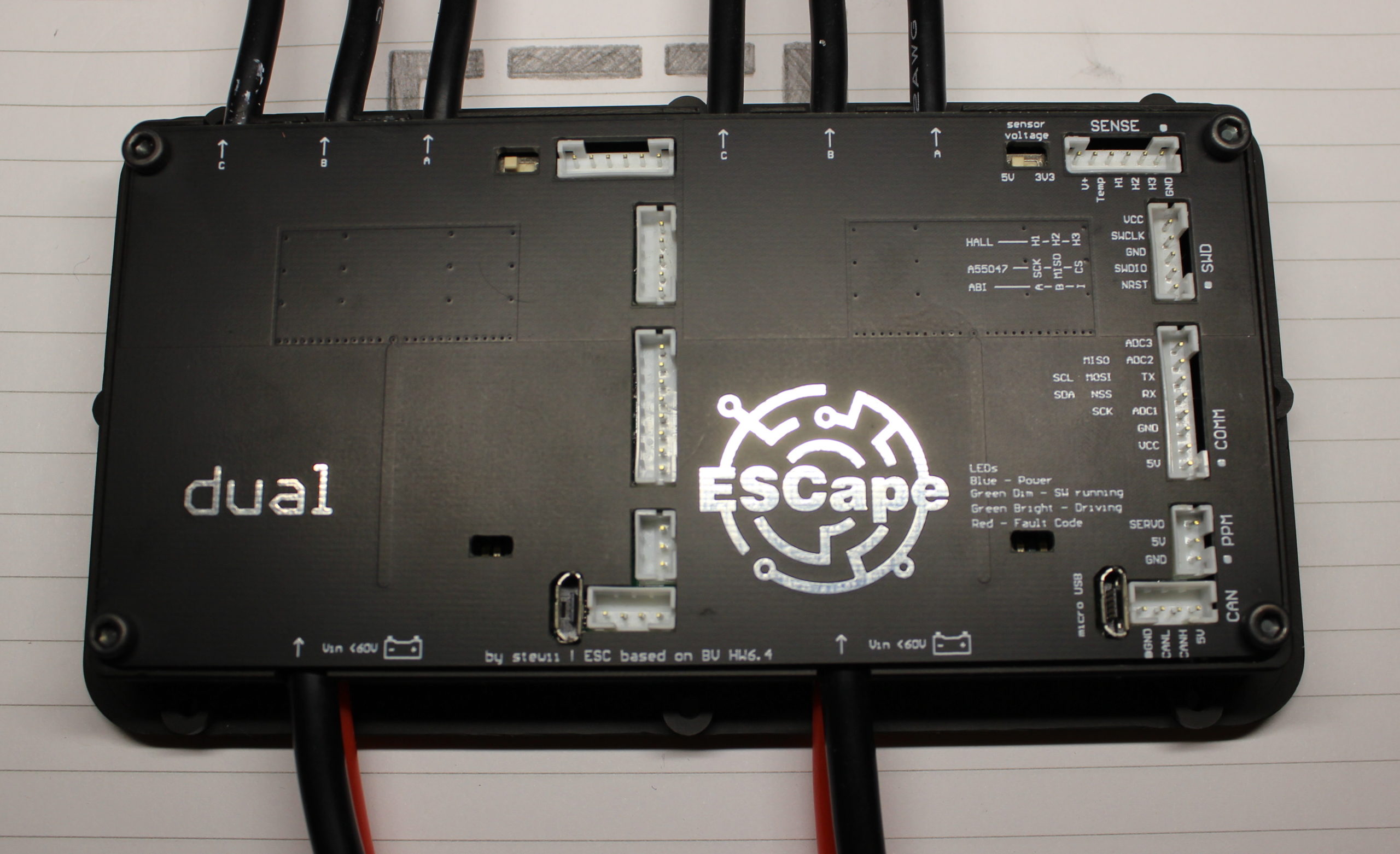
Introduction
Back in late 2017, user Stewii on the .builders forum introduced everyone to his take on the VESC 6.4 Schematics: The ESCape. Shortly after, a handful of group buys were organised to give the people what they wanted. However, after the successful completion of those group-buys, Stewii seemingly dropped off the face of the universe. He was no longer active on threads, and no further groupbuys were organised. Over time, the ESCape proved itself to be one of the most reliable, power-capable VESC variants, seconded only to the official Trampa VESC, and followed by the infamous FOCbox. Suddenly, every ESCape that existed was part of a rare breed and were sought after heavily.
Flash forward to late 2019, over 2 years later, as esk8.news takes a look back at the ESCape, and how they perform with today’s practices.
Sizing- 8/10
The ESCape exists in two offerings: A single and a dual. The single measures in at 70x77x20mm, whereas the dual is 137×72.x24mm. The single is similarly sized to other ESC’s in this range, with it slightly larger that the Trampa VESC (75x70x18mm), and also larger than the FOCbox (64x64x22mm).
The dual variant of the ESCape is simply two single ESCape PCB’s in a single housing, so it is larger than other offerings of Dual ESC’s which share a conjoined PCB. This also aids in reliability, but we’ll touch on that later.

If space is at a premium on your build, you would be hard-pressed to use an ESCape, unless you really want to put serious power down.
Reliability- 9.5/10
Nobody likes an ESC failure, especially on an Esk8. ESC’s are expensive, and when they fail, it can mean streetface and other serious injury. The ESCape is time-tested and power-proven as it continues to perform reliably in builds. Although safely rated for 12s (50.4 v), some users have chosen to run these at 13s (54.6 v). It seems that as long as they are cooled properly, you can push closer to the component limit of 63v*. This is easily done with the ESCape dual, as it’s housing features an integrated heat sink, which can be interfaced through an enclosure to receive active cooling.

In terms of Power, the ESCape is as reliable as it comes, with users reporting an impressively low failure rate. The only thing preventing the ESCape from receiving a perfect score in reliability is a flaw that plagued other ESC’s at the time: CAN death. If your ESCapes are connected via CAN and one is powered on or off before the other while connected, the CAN communication chip will be fried, and unable to be used. Since discovered, the flaw has been patched by other ESC manufacturers, but because Stewii went MIA early on, there was never a second hardware iteration to solve the issue, which places the ESCapes at a slight disadvantage to their competition.
In regards to other dual ESC’s, the ESCape’s design is ingenious and a true testament to the KISS principle. Other dual ESC’s share a conjoined PCB, which is more space-efficient, but means that in the event of a failure of one of the “halves”, the dual package is useless as a dual. Since the ESCape is simply two singles in a conjoined enclosure, in the unlikely event of a failure of one of the halves, it can be removed and replaced, without impeding the integrity of the other.
(*ESC’s are subject to inductive loads, which means that they can be subject to greater voltages from regenerative braking than it is subject to outputting. Esk8.news does not condone or recommend running your hardware at greater than 85% of max hardware allowance.)
Price- 10/10
When the ESCape first went on sale, it was as a BOM for the true DIY’er. This meant ordering your own PCB’s, all the parts, soldering things on yourself, and hoping that there was no smoke. Component cost was dirt cheap, and each ESCape would cost sub $50 without an enclosure. Stewie then offered them hand-built with printable enclosure files for $130. With all of the demand for the BOM and the completed ESC, Stewii then began offering the ESCapes with a professional assembly service and included enclosure, for about $120 for a single, and $130 for a dual (None of these prices included shipping costs). The FOCbox was often listed for $190, but was always on sale for about $150, and the Trampa VESC of the time cost about $300 for a single.
Clearly, the ESCape was extremely price competitive, especially in comparison to its closest hardware relative, the Trampa VESC 6*.
(For the sake of not wanting to be sued, I will state that the ESCape is NOT a Trampa VESC6 clone, nor comparable to the same quality standards, customer service, and reliability that is claimed by Trampa Board.)
Conclusion
Since the cease of production of the ESCape, and subsequently the FOCbox, current competition on the current market is slim, and the only readily available, mass-produced (high-performance) single VESC variant that one can buy is the Trampa VESC+. This really highlights a niche in the market, which I will discuss in my next article.
To any aspiring minds reading, and willing to undertake a challenge, take this as a dare to design and pursue another VESC based ESC variant. Many in the community would be willing to support you, supplement your knowledge, help you test, and even eventually, aid in production.
In closing, there is no denying that the ESCape was a serious gem for its time, especially for the esk8 community. To this day, many are appreciative of the work that Stewii contributed, and the ability to own such a top-tier piece of equipment is a privilege even today. With powerful performance, competitive pricing, and high reliability, the ESCape remains one of the DIY’ers favorite ESC’s to use for a high-performance build.
- An Evasive icon: The ESCape - December 6, 2019
- 10 Questions with Slick Revolution - November 22, 2019
